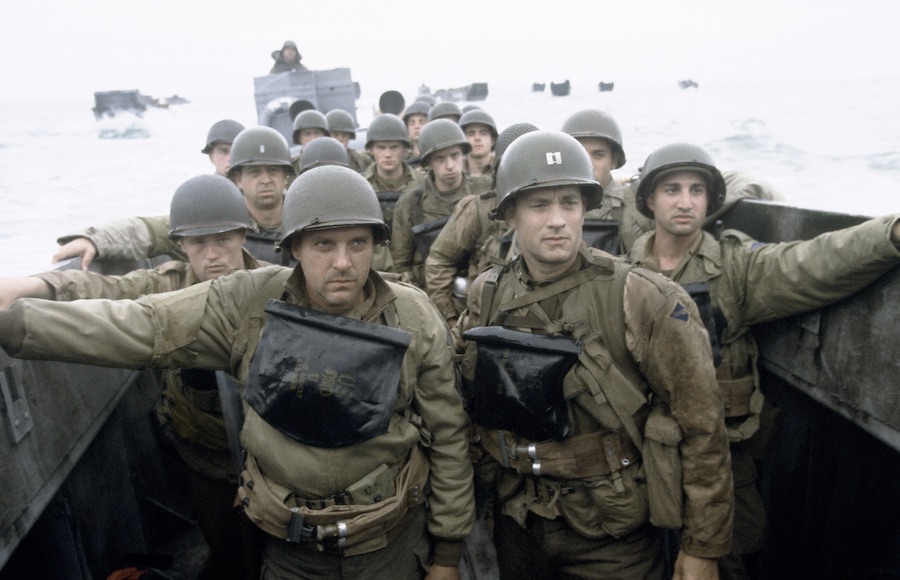
THE MISSION IS A MAN.

Steven Spielberg directed several masterpieces over the years, but this one might be the most controversial. The general sentiment expressed by snobs is that the first 20 minutes, depicting the invasion of Normandy, are outstanding, but the rest is typical Spielberg mush. It’s as if the fact that those 20 minutes are the bloodiest and most shocking of this director’s career automatically makes it more compelling. But there’s more to filmmaking than cleverly edited blood and gore. Saving Private Ryan has become one of the ultimate “guy movies”, the kind of film where it’s OK to cry at the end. We wouldn’t do that if Spielberg had failed to engage our emotions after the conquest of Omaha Beach.
Intense resistance from machine guns
June 6th, 1944. Captain John Miller (Tom Hanks) and his 2nd Ranger Battalion are among the troops landing on Omaha Beach, facing intense resistance from machine guns. The German defense of the beach is crushed, but losses are heavy. In Washington, the military leadership is informed that a woman just lost three of her four sons and that she will receive all three telegrams in one day. Mrs. Ryan’s remaining son, James, is a paratrooper who’s missing in action somewhere in Normandy. General George Marshall (Harve Presnell) orders Ryan to be found and sent home to take care of his family.
The mission is handed to Captain Miller, who assembles a group of men from his company. None of them is particularly enthusiastic, because the mission looks like a propaganda deal without any real value…
Brutal tragicomedy
Those first 20 minutes are indeed noteworthy. Watching the invasion on a big screen, as bullets seem to whizz past you, is genuinely unsettling and the theme of random death runs throughout the film. There’s brutal tragicomedy, as in a scene where a bleeding soldier is killed by a stray bullet to the head just when medics managed to stabilize him on the beach. Since D-Day has always been hailed as a great victory, audiences at the time of the film’s release were shocked to see just how gruesome the invasion was.
It takes some heavy breathing for us to calm down after that opening, but then the film gets to introduce its characters properly. As Captain Miller and his men move deeper into the French countryside looking for Private Ryan, that sense of fear and unease that we got from the opening stays with us (and the soldiers) and there are a number of other incredibly intense encounters with German troops that keep us on edge, especially near the end, which has a big battle in the ruins of a town. Spielberg and screenwriter Robert Rodat examine the meaning of leadership, courage and values in war, while also committing us to these characters, especially Captain Miller as portrayed by Hanks. It’s a combination of honesty, bravery, skill and complete lack of bullshit that makes Miller so compelling – and the ending such a tearjerker.
John Williams wrote an amazingly powerful hymn for the score that fits this patriotism well
The effort to make the film as realistic as possible is combined with old-fashioned American mythology of the scenes back home, but it’s Spielberg’s artistic vision and hard to resist. The film is beautifully and patriotically bookended by images of a big American flag waving in the wind; John Williams also wrote an amazingly powerful hymn for the score that fits this patriotism well.
The bleached colors of Janusz Kaminski’s cinematography remind us of newsreel footage from the war. Combined with Michael Kahn’s editing, the overall effect of these two artists’ achievement under Spielberg’s guidance is almost as devastating and gripping as that other WWII masterpiece they made five years earlier, Schindler’s List.
Saving Private Ryan 1998-U.S. 169 min. Color. Directed by Steven Spielberg. Screenplay: Robert Rodat. Cinematography: Janusz Kaminski. Music: John Williams. Editing: Michael Kahn. Cast: Tom Hanks (John Miller), Edward Burns (Richard Reiben), Tom Sizemore (Mike Horvath), Jeremy Davies, Vin Diesel, Adam Goldberg, Barry Pepper, Giovanni Ribisi, Matt Damon, Dennis Farina, Ted Danson… Bryan Cranston, Paul Giamatti.
Trivia: Co-produced by Spielberg. Mel Gibson and Harrison Ford were considered for the part of Miller; Edward Norton as Private Ryan.
Oscars: Best Director, Cinematography, Editing, Sound, Sound Effects Editing. Golden Globes: Best Motion Picture (Drama), Director. BAFTA: Best Special Effects, Sound.
Last word: “I was making up the entire opening attack of the landings at Omaha Beach. I did the whole thing stream of consciousness. I had no storyboards, no pre-visualization on the computer, did the whole thing from actually up here [points to his head], in a weird way being informed by all the literature I had read about the up-close-and-personal experience of what it was like to survive that day on Omaha Beach. I didn’t know it was going to take four weeks to shoot 26 minutes of movie. When people would come over to me and say, ‘Are we going to be done next week?’ I’d say, ‘I don’t know.’ Because the whole thing was being improvised, in a very safe, rational, controlled way, but improvised nonetheless, and I think if anything gave that scene its impact, its first person, in-your-face impact, it was because I didn’t know what was going to happen next, just like real combat.” (Spielberg, DGA)
